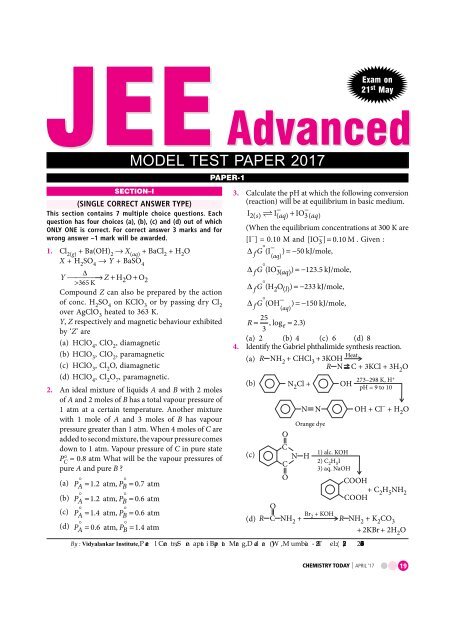Chemistry_Today_April_2017_vk_com_stopthepress
You also want an ePaper? Increase the reach of your titles
YUMPU automatically turns print PDFs into web optimized ePapers that Google loves.
Exam on<br />
21 st May<br />
M O D E L T E S T P A P E R 2 0 1 7<br />
SECTION–I<br />
(SINGLE CORRECT ANSWER TYPE)<br />
This section contains 7 multiple choice questions. Each<br />
question has four choices (a), (b), (c) and (d) out of which<br />
ONLY ONE is correct. For correct answer 3 marks and for<br />
wrong answer –1 mark will be awarded.<br />
1. Cl 2(g)<br />
+ Ba(OH) 2<br />
→ X (aq)<br />
+ BaCl 2<br />
+ H 2<br />
O<br />
X + H 2<br />
SO 4<br />
→ Y + BaSO 4<br />
∆<br />
Y →Z+ HO+<br />
> 365 K 2 O2<br />
Compound Z can also be prepared by the action<br />
of conc. H 2<br />
SO 4<br />
on KClO 3<br />
or by passing dry Cl 2<br />
over AgClO 3<br />
heated to 363 K.<br />
Y, Z respectively and magnetic behaviour exhibited<br />
by ‘Z’ are<br />
(a) HClO 4<br />
, ClO 2<br />
, diamagnetic<br />
(b) HClO 3<br />
, ClO 2<br />
, paramagnetic<br />
(c) HClO 3<br />
, Cl 2<br />
O, diamagnetic<br />
(d) HClO 4<br />
, Cl 2<br />
O 7<br />
, paramagnetic.<br />
2. An ideal mixture of liquids A and B with 2 moles<br />
of A and 2 moles of B has a total vapour pressure of<br />
1 atm at a certain temperature. Another mixture<br />
with 1 mole of A and 3 moles of B has vapour<br />
pressure greater than 1 atm. When 4 moles of C are<br />
added to second mixture, the vapour pressure <strong>com</strong>es<br />
down to 1 atm. Vapour pressure of C in pure state<br />
P° C<br />
= 0.8 atm What will be the vapour pressures of<br />
pure A and pure B ?<br />
(a) P<br />
°<br />
A = 12 . atm, P<br />
°<br />
B = 07 . atm<br />
(b) P<br />
°<br />
A = 12 . atm, P<br />
°<br />
B = 06 . atm<br />
(c) P<br />
°<br />
A = 14 . atm, P<br />
°<br />
B = 06 . atm<br />
(d) P<br />
°<br />
A = 06 . atm, P<br />
°<br />
B = 14 . atm<br />
PAPER-1<br />
3. Calculate the pH at which the following conversion<br />
(reaction) will be at equilibrium in basic medium.<br />
I2() s I( −<br />
aq) + IO3<br />
−<br />
( aq)<br />
(When the equilibrium concentrations at 300 K are<br />
[I – ] = 0.10 M and [ IO3 − ] = 010 . M . Given :<br />
∆ f G<br />
° ( I<br />
− )= −50<br />
kJ/mole,<br />
( aq )<br />
∆ f G ° ( IO3 − ( aq )) = − 123.<br />
5 kJ/mole,<br />
∆ f G ° ( HO 2 ( l ))<br />
= −233<br />
kJ/mole,<br />
∆ f G<br />
° ( OH<br />
− )= −150<br />
kJ/mole,<br />
( aq)<br />
25<br />
R = ,log e = 23 .)<br />
3<br />
(a) 2 (b) 4 (c) 6 (d) 8<br />
4. Identify the Gabriel phthalimide synthesis reaction.<br />
(a) R NH 2<br />
+CHCl 3<br />
+3KOH Heat<br />
R N C + 3KCl + 3H 2<br />
O<br />
(b) NCl +<br />
2<br />
OH<br />
(c)<br />
O<br />
C<br />
N<br />
C<br />
O<br />
O<br />
(d) R C NH 2 +<br />
273–298 K, H+<br />
pH = 9 to 10<br />
–<br />
N N OH + Cl + H2O<br />
Orange dye<br />
H<br />
1) alc. KOH<br />
2) C2HI<br />
5<br />
3) aq. NaOH<br />
Br + KOH<br />
2<br />
COOH<br />
+ CHNH<br />
COOH<br />
2 5 2<br />
R NH 2 +K CO 2 3<br />
+ 2KBr+2H O 2<br />
By : Vidyalankar Institute, P ear l C en t r e, S en a p at i B ap at M ar g , D ad ar ( W) , M u m b ai - 28. T e l .: ( 022)<br />
CHEMISTRY TODAY | APRIL ‘17 19


